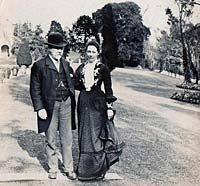
Heavitree House
Page added 6th June 2012
 The destruction of much of Exeter during the war, and the wanting vandalism perpetrated upon the city after the war, led to the loss of many fine buildings. One such victim of the City Council's myopic policies was the demolition of Heavitree House, the former home of Richard Ford, traveller, linguist and writer. Ford had travelled extensively in Southern Spain, between 1830 and 1833, growing to love the country.
The destruction of much of Exeter during the war, and the wanting vandalism perpetrated upon the city after the war, led to the loss of many fine buildings. One such victim of the City Council's myopic policies was the demolition of Heavitree House, the former home of Richard Ford, traveller, linguist and writer. Ford had travelled extensively in Southern Spain, between 1830 and 1833, growing to love the country.
Upon his return to England, Richard Ford purchased what was described as an Elizabethan cob cottage in Church Lane, Heavitree in the late summer of 1834. The house stood in twelve acres of land, on the opposite side of the lane from Heavitree Church, on a rolling hillside looking across the open countryside that would one day be the Royal Devon and Exeter Hospital site.
Ford set to work enlarging the house and laying out new gardens. He started immediately by removing the cob, let in the light, and opened up his view of his estate. The early 19th Century in Exeter was as much a time of change as the next century, with the Improvement Commission widening streets, and constructing the Ironbridge and Higher and Lower Markets. Ford took the opportunity to scavenge architectural salvage from many of the victims of this progress. The fireplace in the hall came from an ancient house pulled down in Rack Street while the gates, the stair-case, much of the panelling and carved woodwork were salvaged from King John's Tavern situated in South Street.
During his extensive travels through Spain, Ford collected items. The cornice of the bathroom had once decorated the Casa Sanchez in the Alhambra. The old Register chest from Exeter Cathedral formed the case of the bath. The house became the home for many books and curios that he had collected while abroad – pictures, etchings, engravings, and specimens of Majolica ware were displayed in the house.
Ford's love of Spain found a practical outlet in his landscaping of the gardens. He wrote "I have already begun digging, and moving plants ; to-morrow comes my man of mortar to plan the kitchen. My pink thorn will be out in a month : quite a nosegay. You can't think how snug my upper drawing-room looks, now it is full of books, ormolu, drawings, etc." He planted Moorish-patterned flower borders, planted pines from the Pincian and cypresses from the Xenil. When Heavitree Church was rebuilt in 1844, Richard Ford acquired the font, which he placed in his garden.
In December 1836, Ford told his friends that the house and gardens were finished. A letter to a friend stated "Heavitree, is finished and furnished, and really is a little gem in its way." The house was quite unlike any other in the district, bringing a touch of exoticism to Exeter. He remained there until his death in August 1858.
After the death of Richard Ford, the house passed to his son, Clare, who let it. It was finally sold in 1898, to Edward and Annie Shrimpton, who lived in it until just before the First World War. Edward Shrimpton was a draper from Winchester in Hampshire. He owned several other houses in Exeter, including South Lawn in Magdalen Road, along with farms and land outside the city, and a stable of racehorses.
During the Second War the house was used as a workshop, and much abused. It was Grade II listed in 1947, but alas, it did not save it. In 1949, the house was quite derelict, while a housing estate had been erected in the grounds. The City Council had the building demolished, and more housing went on the site, removing all traces of what would have been a fine property for the National Trust or English Heritage's stewardship, while the tall cob wall aling Church Lane is all that remains of this fine house.
Sources: Letters of Richard Ford and Discovering Exeter, Aspects of Exeter by Thomas/Warren, Heavitree byTrevor Fall, andpersonal notes from Mark Shrimpton.
 The house from the east showing the gardens. All three photos were taken in 1939. Note that one of the leylandii is visible in the photo, below, taken before the First War.
The house from the east showing the gardens. All three photos were taken in 1939. Note that one of the leylandii is visible in the photo, below, taken before the First War. A previously unpublished photograph showing a detail of the entrance to the house. The Moorish influenced design around the porch is a striking example of Richard Ford's love of Spain. Photo courtesy of Mark Shrimpton.
A previously unpublished photograph showing a detail of the entrance to the house. The Moorish influenced design around the porch is a striking example of Richard Ford's love of Spain. Photo courtesy of Mark Shrimpton. Edward and Annie Shrimpton, lived in the house from around 1898 until just before the First World War. Here, they are pictured in the garden – the summer house can just be seen in the rear, left. Photo courtesy of Mark Shrimpton.
Edward and Annie Shrimpton, lived in the house from around 1898 until just before the First World War. Here, they are pictured in the garden – the summer house can just be seen in the rear, left. Photo courtesy of Mark Shrimpton.│ Top of Page │

